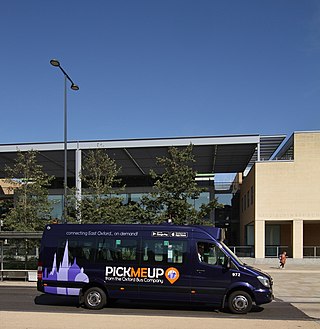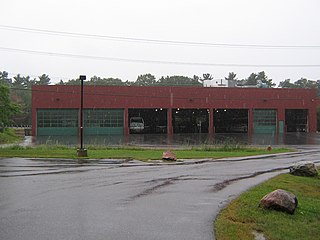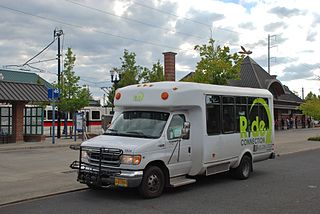
Sandy Area Metro is a public transit system operated by the city government of Sandy, Oregon. SAM was created after the city successfully petitioned to be removed from the TriMet district in the late 1990s. The name was chosen in July 1999, and service began operating on January 4, 2000. The local transit provider gave its one-millionth ride on November 21, 2006 and began its twentieth year in January 2019. SAM maintains three routes, a dial-a-ride service called Sandy Transit Area Rides (STAR), and an Elderly and Disabled (ED) medical rides program.

C-Tran, more formally the Clark County Public Transit Benefit Area Authority, is a public transit agency serving Clark County, Washington, United States, including the cities of Battle Ground, Camas, Vancouver, Washougal, and Yacolt. Founded in 1981, C-Tran operates fixed route bus services within Clark County, as well as paratransit services for qualified persons with disabilities (C-Van) and a dial-a-ride service in Camas, Ridgefield, and La Center. C-Tran also provides express commuter services between Clark County and various points in Portland, Oregon, including downtown, the Parkrose/Sumner and Delta Park MAX Light Rail stations, Lloyd District, and Oregon Health and Science University. In 2022, the system had a ridership of 4,088,200, or about 13,600 per weekday as of the fourth quarter of 2022.
StarMetro is the city-owned and operated public bus service for Tallahassee, Florida, and was previously known as TalTran. StarMetro operates both fixed-route and dial-a-ride service in the Tallahassee metropolitan area.

Chittenden County Transportation Authority (CCTA) was the public transit system headquartered in Burlington in Chittenden County, Vermont. CCTA served the communities of Burlington, Essex, South Burlington, Winooski, Shelburne, Williston and Milton. As well as providing regular bus routes to these member municipalities, CCTA also served parts of Colchester and had express routes for commuters travelling between Burlington and Montpelier, Middlebury, and St. Albans.

VCTC Intercity is a public transit agency providing bus service in Ventura County, California. It provides an intercity bus service between the cities of Ventura, Oxnard, Camarillo, Thousand Oaks, Moorpark, Santa Paula, and Fillmore in Ventura County, and to communities in neighboring Los Angeles and Santa Barbara counties. The agency is part of the Ventura County Transportation Commission, a governmental body that oversees transportation planning and funding in Ventura County. In 2022, the system had a ridership of 349,500, or about 1,200 per weekday as of the fourth quarter of 2022.

Plymouth Metrolink is the public transit system that serves Plymouth, Minnesota. Metrolink operates fixed-route bus routes Monday-Friday during peak periods with limited midday service. Most routes serve downtown Minneapolis and the University of Minnesota with one route providing reverse commute service from Minneapolis to employers in Plymouth. Demand-responsive bus service is available seven days a week. Most buses are provided by the Metropolitan Council with First Transit operating the fixed-route service.

Marin Transit is a public bus agency in Marin County, California, in the United States. Originally formed in 1964 as Marin County Transit District (MCTD). Marin Transit was re-branded on 30 July 2007 and now provides a variety of fixed-route and demand-response services using contractors. In 2022, the system had a ridership of 2,628,800, or about 8,100 per weekday as of the fourth quarter of 2022.

Demand-responsive transport (DRT), also known as demand-responsive transit, demand-responsive service, Dial-a-Ride transit, flexible transport services, Microtransit or Non-Emergency Medical Transport (NEMT) is a form of shared private or quasi-public transport for groups traveling where vehicles alter their routes each journey based on particular transport demand without using a fixed route or timetabled journeys. These vehicles typically pick-up and drop-off passengers in locations according to passengers needs and can include taxis, buses or other vehicles. Passengers can typically summon the service with a mobile phone app or by telephone; telephone is particularly relevant to older users who may not be conversant with technology.

Needles Area Transit (NAT) is the public transportation system, including a Dial-a-Ride program for seniors and persons with disabilities, serving residents of the City of Needles in San Bernardino County, California. The NAT system transports approximately 34,000 riders each year.

Green Mountain Transit Agency (GMTA) provides public transportation in central Vermont, specifically in Washington and Lamoille counties and parts of Orange County, expanding in 2009 to include Franklin and Grand Isle counties. Their bus routes connect the Capital District, Stowe, Lamoille Valley and the Mad River Valley.

MV Transportation, Inc., based in Dallas, Texas., is the largest privately owned passenger transportation contracting services firm in the United States. The company can provide paratransit, fixed-route, campus and corporate shuttles, and student transportation services, partnering with over 200 city and county government transit agencies, school districts, universities, and corporations. MV serves over 110 million passengers each year across 30 states and Canada with a team of more than 20,000 transit professionals.
Green Mountain Community Network (GMCN) is a private, nonprofit organization, that owns and operates the public transit system by local bus in Bennington County in southwestern Vermont called the Green Mountain Express. Their bus service currently has 3 local "fixed deviated" weekday routes in Bennington: the Red, Blue and Brown routes, which can deviate up to 1/4 mile from their alignment upon request. They also have two local Saturday routes, and three commuter routes: the Orange Line, with weekday plus Saturday service to Manchester; the Purple Line, with weekday service to Williamstown, Massachusetts; and the Emerald line, with weekday service to Wilmington. The Emerald Line is a partnership between West Dover-based Southeast Vermont Transit's "the MOOver" and GMCN.

Yakima Transit is the primary provider of mass transportation in the city of Yakima, Washington. It was established in 1966, as Yakima City Lines, when the city of Yakima began funding the provision of transit service after the privately owned company that had been providing service went bankrupt.

The John W. Olver Transit Center, also called the JWO Transit Center, is an intermodal transit hub for Franklin County, Massachusetts. Located in Greenfield, it currently serves Franklin Regional Transit Authority (FRTA) local bus routes plus intercity bus service. Amtrak's Greenfield station is also located here, with one daily Vermonter round trip and two daily Valley Flyer round trips, which are extensions of Amtrak-run Hartford Line trains.

Green Mountain Transit (GMT) is the regional public transit system based in Burlington, Vermont, which was formed in 2016 through the merger of two more localized transit systems: the Chittenden County Transportation Authority and the Green Mountain Transit Authority. In 2022, the system had a ridership of 1,774,100, or about 7,300 per weekday as of the fourth quarter of 2022.

Ferrisburgh–Vergennes station is an intermodal Amtrak and bus station in Ferrisburgh, Vermont, adjacent to the city of Vergennes. The facility opened in 2007 as a free park and ride lot operated by the Vermont Agency of Transportation (VTrans). Bus service is provided by Tri-Valley Transit and Vermont Translines. The historic station building serves passengers at the Amtrak platform located along the southwest corner of the facility. It was listed on the National Register of Historic Places in 2021 as the Vergennes Station House. Rail service began on July 29, 2022, when the Ethan Allen Express was extended from Rutland to Burlington.

Visalia Transit (VT) is the primary bus agency serving residents and visitors to Visalia, California, the largest city and county seat of Tulare County, California. It is operated by the city through its contractor and offers both fixed routes and dial-a-ride local service within Visalia. In 2022, the system had a ridership of 605,200, or about 2,100 per weekday as of the fourth quarter of 2022.

Ride Connection is a private, nonprofit organization that provides fixed bus route and paratransit services in the Portland metropolitan area in the U.S. state of Oregon. It was founded as Volunteer Transport, Inc. on May 26, 1988.
















